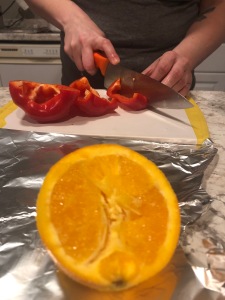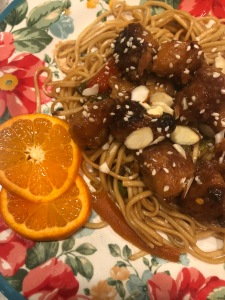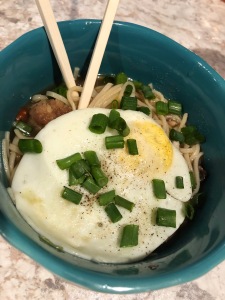Lately, my lovely partner Emily has been craving a good Orange Chicken. She stopped by a popular chain and was highly disappointed. Then, we decided to go to a local spot that we knew had a good Orange Chicken, but this time the orange flavor was lacking. It was good, but it wasn’t very orange–y. We decided if we wanted something done right, we had to do it ourselves — a bold declaration from a couple of fools who had never cooked Orange Chicken.
We got a cheap wok and a basket full of essentials: soy sauce, rice wine vinegar, sesame oil, lo mein, and the holy trinity — garlic, green onion, and ginger. We picked up the desired veggies for our side of lo mein: broccoli, green beans, carrots, and a red bell pepper. And we got a little box of baby portabella mushrooms. To make our Orange Chicken truly orange, we picked up a big orange, and for balance, a couple of lemons. We got some chicken breasts, olive oil, corn starch, and after breaking the bank, we were finally done shopping. It was time to prep. I started by cleaning the wok while Emily cut up the vegetables.
She cut the broccoli into small florets — uniform — each one about a square inch. The green beans were cut about an inch long, and the bell pepper was julienned before being chopped into a similar length. She used the side of an old cheese grater to cut the carrots into long thin strips. I gave her a break and sliced the mushrooms into pieces about a quarter of an inch thick.
Then, we made our sauces.
She started the sauce for the chicken by mixing together water, soy sauce, rice vinegar, orange juice, and lemon juice. She mixed it in a saucepan so it was ready to be put on the stove. After pouring in her liquid ingredients, she put it on the stove on medium-high heat. While it was starting to boil, she chopped garlic, green onion, and ginger. Then, she added the holy trinity to the sauce with brown sugar and crushed red pepper flakes. Once it was really boiling, she turned the stove eye off.
For the noodles, I made a stir fry sauce consisting of soy sauce, chicken broth, sesame oil, and sugar. It smelled and tasted really heavily of sesame, so I poured half of it down the drain and filled the rest of the cup up with soy sauce. Whatever.
Emily cut the chicken into strips a half-inch thick before marinating it in some of the orange sauce she made.
We let the chicken marinate in the refrigerator while we cleaned up a bit. Emily mixed salt and pepper into flour for the breading, and we heated a pan and poured in enough peanut oil to halfway submerge each piece of breaded chicken.
Emily pan-fried the chicken, and I started boiling a pot of water for the lo mein noodles. When the chicken was fully cooked, we tasted a piece, and OMG! Delicious. We decided we would probably always use that orange sauce as a chicken marinade for any chicken we ever fried.
When the water was boiling, rolling, in went the noodles. I set a timer for six minutes and removed the garlic, green onion, and ginger from our wok. That’s right. This one isn’t my wok. It’s our wok. I heated the wok, added a teaspoon of peanut oil, and tossed in the veggies. I tried to constantly move them around so that each piece spent the same amount of time in the well in order to get a uniform cook. After a few minutes, I realized that I should have added the green beans first and cooked them for a bit before adding the rest of the veggies. If I had waited until they were cooked to the desired doneness, then the other ingredients would have been overcooked.
Once the vegetables were done, I added the stir-fry sauce. I let the veggies simmer in the sauce, trying to get those damn green beans to just be soft! Then, I added the noodles. I tossed it all around and then lowered the heat to just high enough to keep it all warm.
Emily added the sauce to the chicken and tried to thicken it up with some heat and corn starch. And once it was thick enough, she plated the lo mein and put the orange chicken on top. She garnished the dish with sesame seeds and orange slices. Beautiful. This has to be delicious, right?
Well, I had added way too much sesame oil to the sauce. The sesame flavor was overpowering. Other than that, the noodles and veggies were pretty good. I loved the chicken. Emily thinks the corn starch gave the orange sauce and chicken a bad texture. I know what she means, but it didn’t make it unenjoyable. I think maybe if the corn starch had been cooked into the sauce more, it wouldn’t have had that bad texture. I thought the orange chicken was quite delicious. Sweet, savory, tangy, umami, lovely.
The next day, Emily used the leftover ingredients to make a noodle soup, and I have to be honest; it may have been way better than the original dish. The broth was chicken broth, soy sauce, water, and — admittedly — a little store-bought teriyaki sauce. She used green beans she had cooked correctly and all the other leftover vegetables with some garlic and ginger. Into that broth went the leftover lo mein noodles, and she topped it with a fried egg. 
That’s it. That’s the story of our first attempt at Orange Chicken. It was certainly a learning experience. We decided it would have been perfect without the overwhelming sesame flavor and the corn starch. Now we know! Now… we know.



